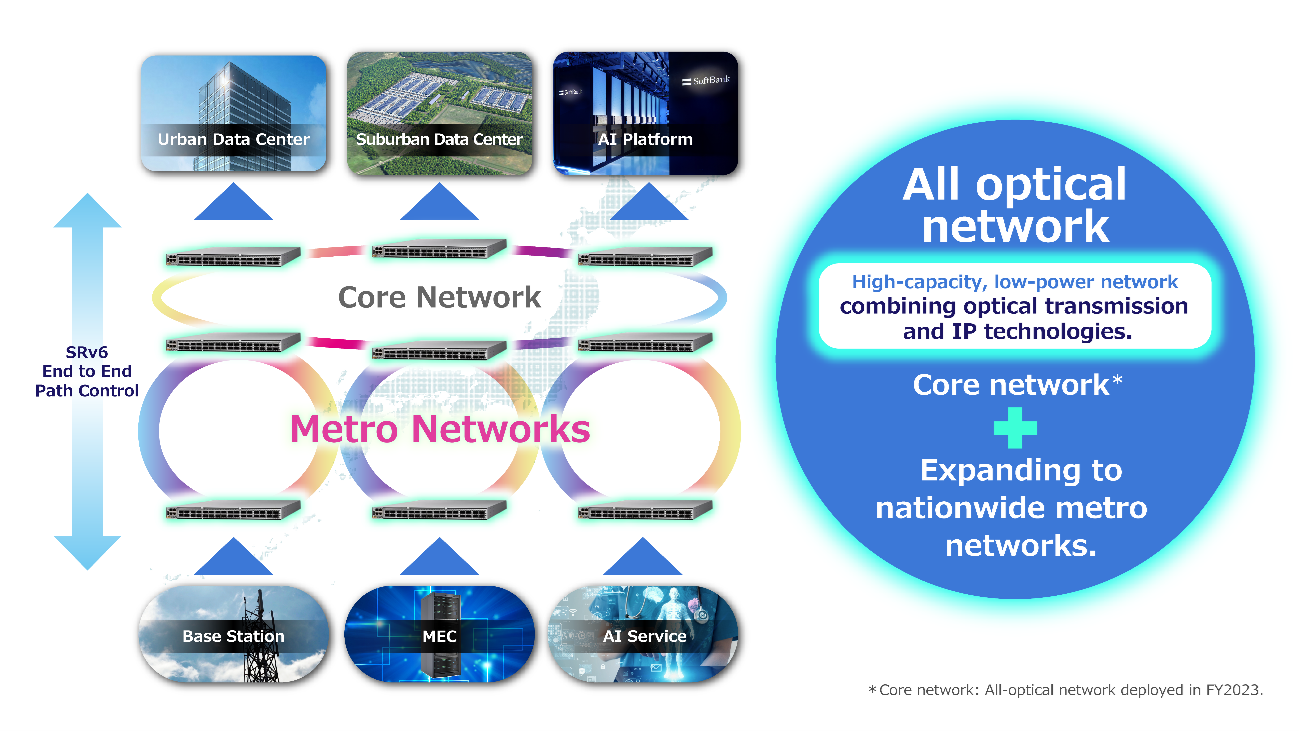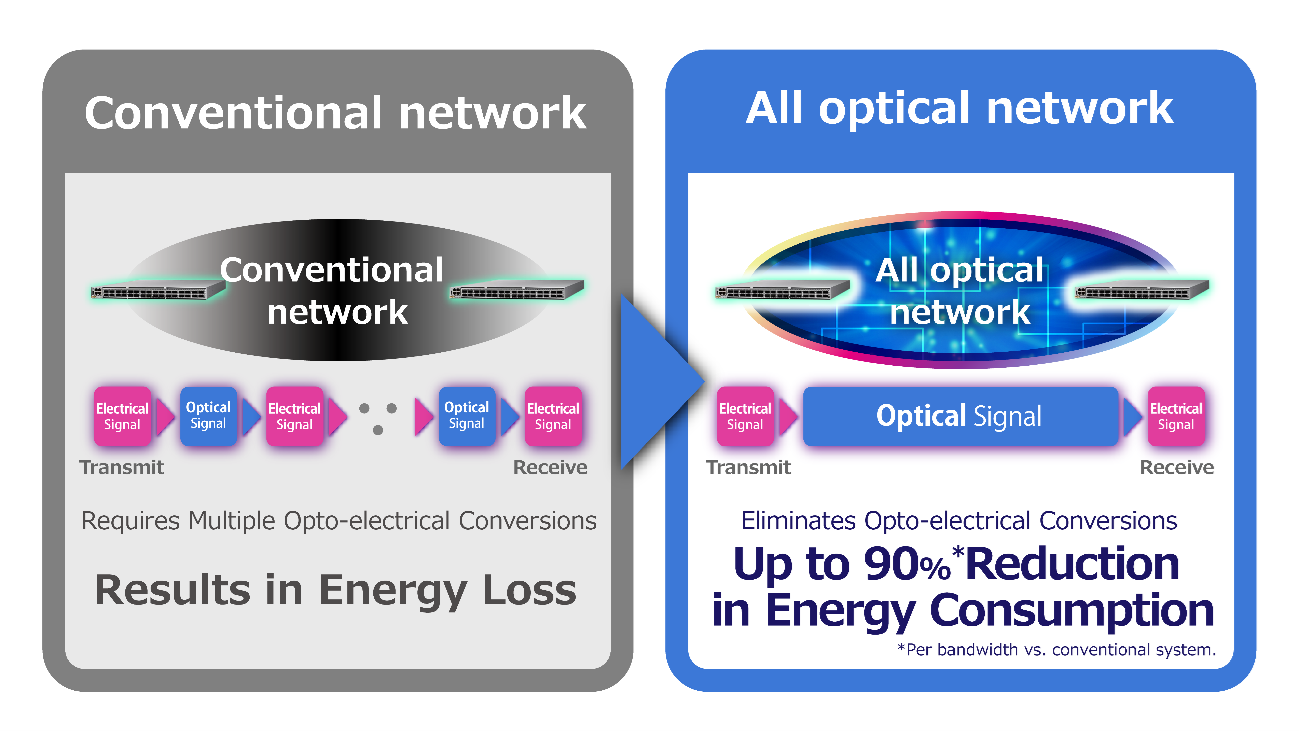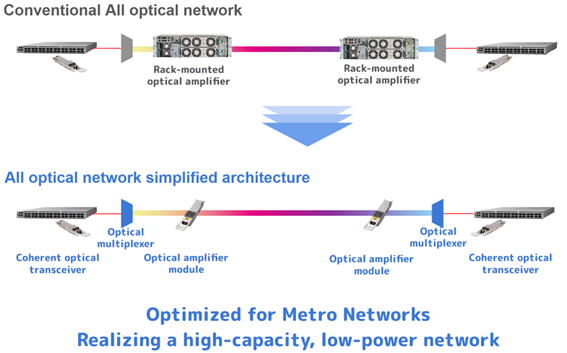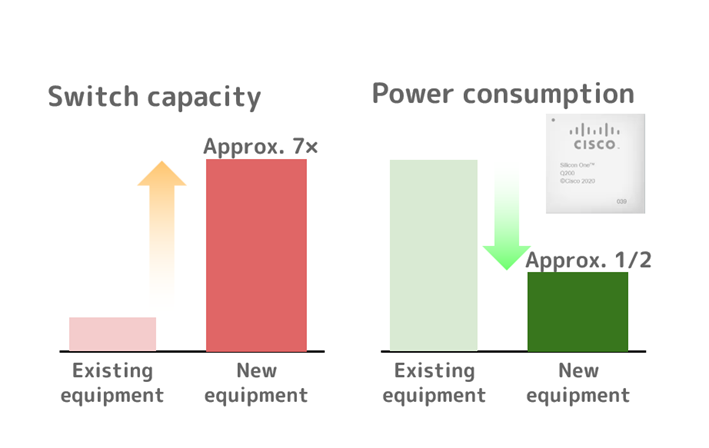Japanese | English
SoftBank Corp. Collaborates with Cisco to Launch Deployment of Optical Transmission Technology “All optical network” in Metro Networks Across Japan
– Technology reduces energy consumption by approximately 90% through the introduction of 400G-capable routers, building a large-capacity, sustainable communication infrastructure –
SoftBank Corp. (“SoftBank”) has partnered with Cisco Systems G.K. (“Cisco”) to begin deployment of the “All optical network” in Japan’s metro networks (*1). The technology significantly reduces energy consumption by eliminating the need for optical-electrical conversion (*2). The first phase was completed in the initial area of Osaka Prefecture in September, 2025. This All optical network for metro networks uses optical technology throughout the communication network and adopts simplified, converged IP and optical architecture. By introducing Cisco’s latest routers that support 400GbE (Gigabit Ethernet) and adopting a simplified architecture optimized for metro networks, the system enables a large-capacity network while reducing energy consumption by approximately 90% compared with conventional configurations (*3).
SoftBank plans to complete the deployment of the All optical network in metro networks nationwide by 2027. SoftBank and Cisco will develop high-capacity metro networks with superior scalability to accommodate the increasing data traffic driven by the widespread adoption of AI and the Beyond 5G/6G era. Additionally, both companies will promote the construction of a sustainable communication infrastructure that contributes to achieving net zero targets.
(*1) Refers to the network that connects the core network and the access network.
(*2) In communications, the process of converting a signal received as light into an electrical signal, processing it, and then converting it back into light for transmission. This conversion process requires a significant amount of power.
(*3) A comparison with the configuration using routers, transponders, optical multiplexers, and optical amplifiers that SoftBank has conventionally used in its metro networks.
Background of All optical network Deployment in Metro Networks
With the rapid increase in data traffic due to generative AI and cloud services, even greater traffic demand is expected in the Beyond 5G/6G era. Meanwhile, communication providers are required to reduce environmental impact and build more sustainable communication infrastructure. In this context, SoftBank completed the deployment of the All optical network nationwide in core networks in October 2023 (*4). This initiative is now being expanded to metro networks nationwide, connecting base stations, AI services, and other user-proximate points to the core network.
(*4) For details, please see the SoftBank press release dated November 10, 2023, “SoftBank Corp. completes nationwide expansion of all optical network in core areas in Japan leveraging Fujitsu’s disaggregation-type optical transmission system“
 Figure 1. New scope of All optical network deployment
Figure 1. New scope of All optical network deployment
Key Features of the All optical network Deployment in Metro Networks
- Integration of All optical network and IP Network
By equipping IP routers with Cisco 400G coherent (*5) optical transceivers “OpenZR+” (*6), which enables long distances, high-capacity optical transmission, all optical connections are achieved without any optical- electrical conversion along the path. This achieves an approximate 90% reduction in energy consumption compared to the conventional configuration (*7). Furthermore, by leveraging IP network technologies such as SRv6 (Segment Routing IPv6), for large-scale and flexible route control including end-to-end management from the core to the edge, which has traditionally been a challenge for typical all-optical network. By integrating IP technology, the network achieves both power efficiency and scalability.
(*5) In contrast to the conventional method of signal transmission using light intensity (on/off), this method transmits signals using the phase and polarization of light. It is suitable for transmitting large-capacity signals over long distances due to less signal degradation.
(*6) A Multi-Source Agreement (MSA) standard for optical transceivers that use digital coherent technology, allowing optical signals to be processed with digital compensation.
(*7) Comparison with the conventional configuration of routers and transponders used by SoftBank in its metro networks for the link between the router and the optical multiplexer (excluding the optical multiplexer itself).

Figure 2. Comparison of the conventional network and the All optical network
- Adoption of a Simplified Architecture Suitable for Metro Networks
While long-distance optical signal transmission, such as in core networks, has traditionally required the installation of rack-mounted optical amplifiers, the All optical network for metro networks, which is not intended for long-distance transmission, introduces Cisco’s newly developed QSFP-DD Pluggable Open Line System (OLS), a palm-sized optical amplifier module that can be directly installed on routers. By combining this module with SoftBank’s independently developed optical multiplexer—which requires no external power supply and supports up to 6.4 Tbps—more than a 90% reduction in energy consumption compared to conventional configurations (*8) is achieved. This enables the realization of an optimal metro network that is compact, energy-efficient, and scalable.
(*8) Comparison with the conventional configuration of optical multiplexers and optical amplifiers used by SoftBank in its metro networks for the link between optical multiplexers.

Figure 3. Simplified All Optical Architecture
- Introduction of Cisco’s Latest Chip, the “Silicon One Q200”
The IP routers connected to the All optical network will be equipped with Cisco’s latest 400GbE-capable chip, the “Silicon One Q200,” to achieve a significant performance improvement. Compared to the conventional router (*9), the Silicon One Q200 provides approximately 7 times the switching capacity while cutting energy consumption by about half.
(*9) Comparison with the previously used router.

Figure 4. Power efficiency improvement
Executive Comments
“Partnering with Cisco to deploy the All optical network across Japan’s metro networks represents a major step forward in building a sustainable and future-ready communication infrastructure,” said Teruyuki Oya, Vice President, Head of Mobile & Network Division, Technology Unit, SoftBank Corp. “In response to the growing data demands driven by AI and next-generation technologies, we are delivering a highly scalable, high-capacity network. Furthermore, by combining IP and optical technologies, we aim to achieve both energy efficiency and flexibility, evolving Japan’s communications foundation into a more resilient and sustainable platform that supports society and industry. ”
“Working with SoftBank to launch the All optical network (*10) in metro networks highlights our shared vision of creating a resilient, energy-efficient network infrastructure,” said Vish Iyer, SVP, APJ Service Provider, Cisco. “This partnership is focused on delivering a scalable, environmentally friendly infrastructure that supports Japan’s digital transformation and AI-driven growth. By combining our strengths, we are helping to build a more efficient connected future that benefits both businesses and citizens across the country.”
(*10) Cisco refers to the architecture supporting this All optical network as “Routed Optical Network (RON),” which is a solution that achieves network simplification and efficiency through the convergence of IP and optical technologies. By leveraging this technology, similar to the current use case, it enables reductions in energy consumption and footprint, as well as simplification of operations.
About SoftBank Corp.
Guided by the SoftBank Group’s corporate philosophy, “Information Revolution – Happiness for everyone,” SoftBank Corp. (TOKYO: 9434) operates telecommunications and IT businesses in Japan and globally. Building on its strong business foundation, SoftBank Corp. is expanding into non-telecom fields in line with its “Beyond Carrier” growth strategy while further growing its telecom business by harnessing the power of 5G/6G, IoT, Digital Twin and Non-Terrestrial Network (NTN) solutions, including High Altitude Platform Station (HAPS)-based stratospheric telecommunications. While constructing AI data centers and developing homegrown LLMs specialized for the Japanese language, SoftBank is integrating AI with radio access networks (AI-RAN), with the aim of becoming a provider of next-generation social infrastructure. To learn more, please visit https://www.softbank.jp/en/corp/
About Cisco
Cisco is the worldwide technology leader that is revolutionizing the way organizations connect and protect in the AI era. For more than 40 years, Cisco has securely connected the world. With its industry leading AI-powered solutions and services, Cisco enables its customers, partners and communities to unlock innovation, enhance productivity, and strengthen digital resilience. With purpose at its core, Cisco remains committed to creating a more connected and inclusive future for all. Discover more on The Newsroom and follow us on X at @Cisco.
- SoftBank, the SoftBank name and logo are registered trademarks or trademarks of SoftBank Group Corp. in Japan and other countries.
- Other company names, product names, and service names mentioned in this press release are registered trademarks or trademarks of their respective companies.